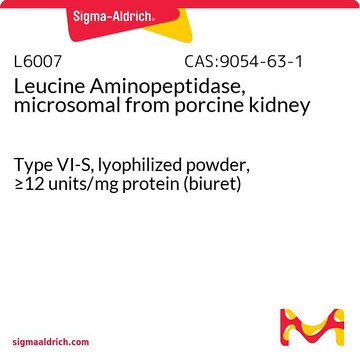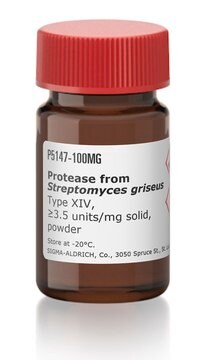P6675
Prolidase from porcine kidney
lyophilized powder, ≥100 units/mg protein
Sinônimo(s):
Aminoacyl-L-proline hydrolase, Imido Dipeptidase, Prolidase, Proline dipeptidase
About This Item
Produtos recomendados
forma
lyophilized powder
atividade específica
≥100 units/mg protein
composição
Protein, 20-74% Lowry
temperatura de armazenamento
−20°C
Procurando produtos similares? Visita Guia de comparação de produtos
Categorias relacionadas
Descrição geral
Aplicação
- in the enzymatic hydrolysis of porcine milk for the recovery of L-glutamine from proteins and peptides
- in the proteolysis of skim milk for the determination of ε-(γ-glutamyl)lysine and free aminoacids
- to determine its effect on the activity of enterococcin A 2000
Ações bioquímicas/fisiológicas
Definição da unidade
forma física
Palavra indicadora
Danger
Frases de perigo
Declarações de precaução
Classificações de perigo
Eye Irrit. 2 - Resp. Sens. 1 - Skin Irrit. 2 - STOT SE 3
Órgãos-alvo
Respiratory system
Código de classe de armazenamento
11 - Combustible Solids
Classe de risco de água (WGK)
WGK 1
Certificados de análise (COA)
Busque Certificados de análise (COA) digitando o Número do Lote do produto. Os números de lote e remessa podem ser encontrados no rótulo de um produto após a palavra “Lot” ou “Batch”.
Já possui este produto?
Encontre a documentação dos produtos que você adquiriu recentemente na biblioteca de documentos.
Os clientes também visualizaram
Nossa equipe de cientistas tem experiência em todas as áreas de pesquisa, incluindo Life Sciences, ciência de materiais, síntese química, cromatografia, química analítica e muitas outras.
Entre em contato com a assistência técnica













